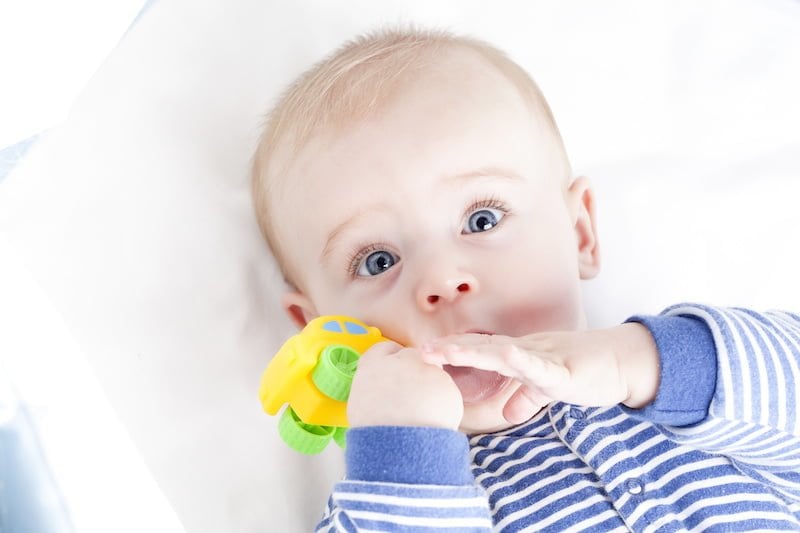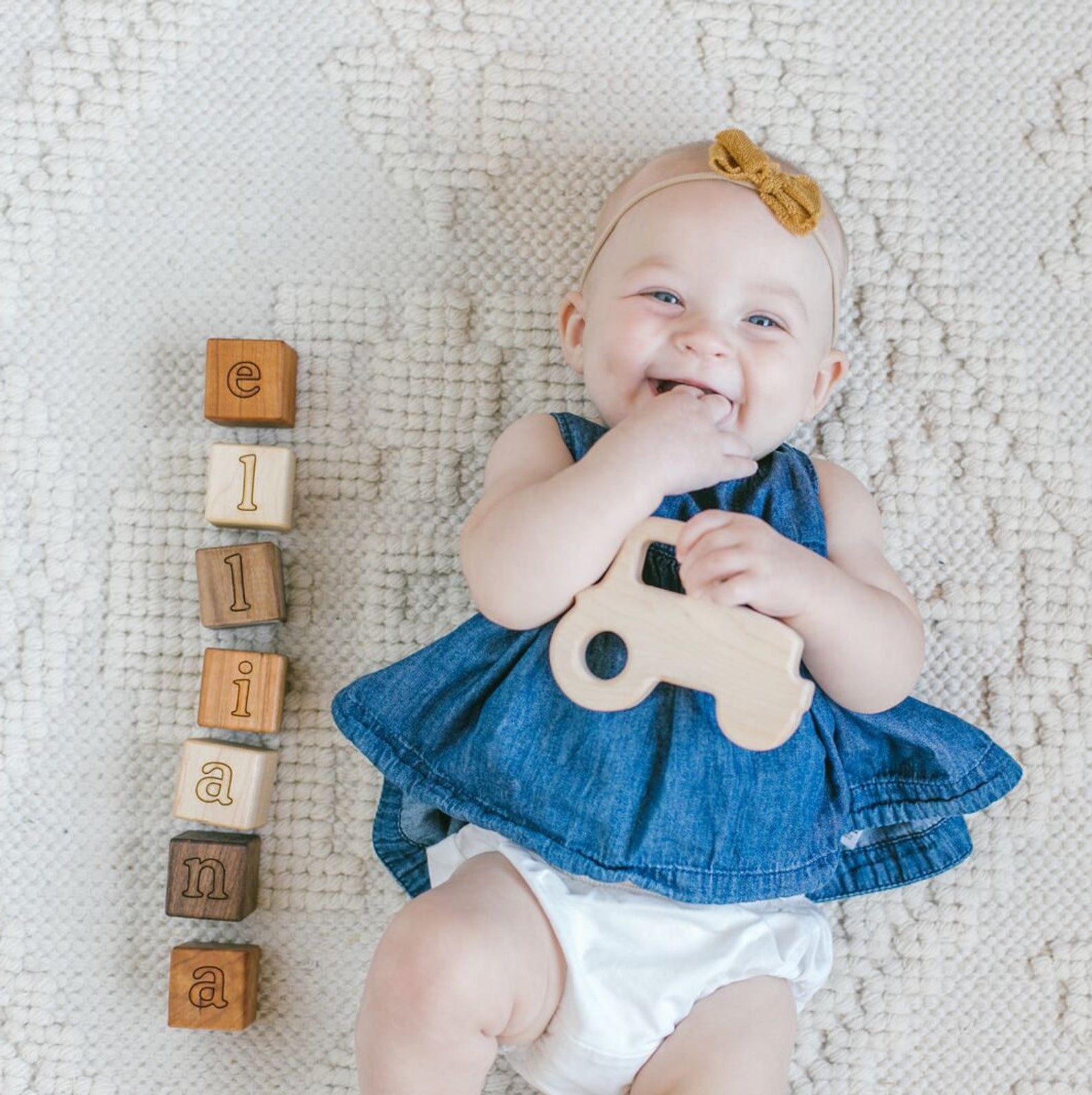Are Plastic Toys Safe for Babies and Kids?
Plastic toys are cute, colorful, easy to find, and usually cheap. But if your baby chews on them, they can ingest dangerous chemicals from the plastic. Here’s what to know about plastic toy safety, plus several great alternative toy materials and options.

Table of contents
Over the past twelve years, we’ve gotten thousands of questions about the safety of plastic toys. Readers ask things like:
- Are plastic toys bad for babies?
- What are phthalates?
- This says it’s free from BPA and phthalates… but what is it actually made of?
- I’ve heard about BPA-free baby bottles and water bottles, but I don’t really understand what BPA was, or why it was harmful.
- And my personal favorite… Who let all these chemicals into baby toys anyway?
Our advice is this… If you have to have a PhD in chemistry to figure out what’s in a product designed for babies and small children, chances are your child shouldn’t be playing with it, chewing on it, or eating or drinking from it.
While many natural parents here in the U.S. feel it’s about time we catch up with Europe and other developed nations on product safety, the majority of parents are left wondering what was wrong with plastic toys in the first place.
The Main Toxins in Plastic Toys
The combination of a few chemicals, mostly found in PVC plastics, is what makes plastic toys dangerous for kids and babies. And some of the danger comes from the way the toys are used – and whether it ends up in a child’s mouth.
The chemicals added to PVC make it the most toxic plastic. And just about every soft plastic toy is made with PVC.
Even worse, you’ll find it in infant items like teething rings, bath toys, and squeeze toys.
One of the most harmful effects of plastic toys and the biggest safety risk with these toxins is that they can leach out – especially when babies or children put the toys in their mouths.
Harmful Additives to PVC
- Phthalates (pronounced thay-lates) give a plastic toy its soft, squishy feel. These are the hormone affecting culprits you may have heard of – endocrine disruptors. Phthalates not only upset the body’s hormonal balance, they’ve also been found to stimulate the growth of cancers.
- Cadmium is a plastic stabilizer. A known carcinogen, cadmium also affects normal brain growth and can cause kidney damage.
- Lead is used to make plastic toys more durable. Lead affects the nervous system and has been linked to hearing loss, ADHD, and decreased IQ. It’s also a concern because children absorb and retain lead in their systems more easily than adults.
- BPA (Bisphenol A) is found in plastic toys, sippy cups, plastic bottles, and canned food lining. It’s considered more of a danger when the child chews on it, so the main concern with BPA has been on food and drink products. But if your child is prone to chewing on toys (and what baby isn’t?) it’s best to avoid plastic toys for that stage.
A study by Denmark Technical University (DTU) showed that more than 100 chemicals found in plastic toy materials can pose health risks to children. In addition to plasticizers, they also found flame retardants and fragrances among the hazardous substances.
These chemicals and their health implications make it understandable why people ask if plastic toys are bad for babies.
The Standards Have Improved… Slightly
Since 2007 – the year of the lead toys recall – safety standards have improved. While it would make our lives easier to just know that products manufactured for babies and children are regulated, unfortunately, it’s still up to the parent to watch what comes into their homes and toy boxes.
In October 2017, the Consumer Product Safety Commission voted to ban five more harmful phthalate chemicals from plastic used in children’s toys after a lawsuit brought by the Natural Resources Defense Council, the Environmental Justice Health Alliance and Breast Cancer Prevention Partners.
Polypropylene Toys – A Somewhat Safer Plastic Option
While still not as good as non-plastic toys, one of the safest plastics for toys is polypropylene. Polypropylene is heat resistant and is unlikely to leach even when exposed to warm or hot water. It’s also approved for use with food and beverage storage.
“Polypropylene is generally considered safe for use, but you should still be wary of using plastics more often than you have to,” reports Dr. Gabriela Pichardo for WebMD. “The chemicals found in plastic products are proven to contribute to some cancers.”
If you inspect toy labels or their brand’s website, you’ll rarely find the type of plastics used in manufacturing listed. For favorite toys that you’re not ready to part with, you can contact the manufacturer to confirm the plastic material makeup.
A Word About LEGOs
It was a big relief for us to find out LEGOs don’t contain PVC or phthalates, and that generally they exceed safety standards. In other good news, LEGO is transitioning to plant-based bricks.
If you saved LEGOs from your childhood, make sure they were manufactured after 1981 before sharing them with your little ones. LEGO historian Gary Istok wrote that by the 1980s, all LEGO bricks were cadmium free. Roar Rude Trangbæk, a spokesperson for LEGO said that in regards to hazardous elements, the company “phased that material out back in 1979 to 1981.” (source)
Safer Alternatives to Plastic Toys
If you still don’t feel comfortable with what your research finds, you may decide it’s best to avoid plastic (and plastic-ish) toys altogether.
Instead choose some of the following safer toy materials for babies and kids:
- wooden toys
- silicone toys (especially for a teething baby)
- cloth toys
- bamboo toys
- toys and teething items made from natural rubber
- wool stuffed animals
- paper and cardboard (once they stop putting things in their mouths so much)
- natural art supplies
- play silks
The brands listed here place a high priority on the safety and environmental impact of their toys.
Green Toys
Lalo
LOVEVERY
Haba USA
Smiling Tree Toys
Bannor Toys
Elves and Angels
Imagine Childhood
Maple Landmark
The Puzzle People
Many of these are Etsy shops and small U.S. based businesses. They’re typically available to answer any questions, and they know what goes into the toys they make. Plus, you can feel good about supporting another family when you buy safe toys for your child.
Take Action for Safer Toys
So aside from buying all wooden toys, what can you do to make sure your child’s toys are safe?
- Only allow your baby to teethe or chew on natural, uncoated wood or a frozen washcloth.
- Sign up for recall updates from the Consumer Product Safety Commission (CPSC). You’ll find the latest information on which toys were recalled and why.
- Call or email the manufacturers of your child’s favorite toys to check if they comply (or are above) current toy safety standards.
- When plastic toys are your only option, go with PVC-free and BPA-free toys, not just for your own children, but for every gift you buy.
- Talk to other parents. Sometimes just bringing up the topic of toy safety at a birthday party helps you realize you’re not alone in wondering what’s best for your child. You may also help educate a fellow parent, which could lead to a healthier family in the long run.
- Contact your state representatives with your concerns about BPA in toys. You might also want to ask why we allow so many toxins in products and foods created for children. If enough people speak up, we may be able to get more strict rules in place.
- Vote with your dollars. This is ultimate way to shape the future. Yes, plastic-alternative toys are more expensive. But they usually last much longer. And your child’s health is worth the investment.
More on Safe Toys for Babies and Kids
These articles offer more advice and ideas about choosing safer toys and baby care items. And you can stay up to date with all the latest on natural parenting when you subscribe to Green Child Magazine.
Why and How to Choose Battery Free Toys
Eco-Friendly Gifts for Kids
Eco-Friendly Gifts for Babies
Baby Gear Guides
Are Battery Toys Bad for Babies?
How to Set Up a Montessori Playroom
How to Avoid Toxic Chemicals in Toys
Why Children Need Open-Ended Play
This article was published in 2012 and updated in 2025

